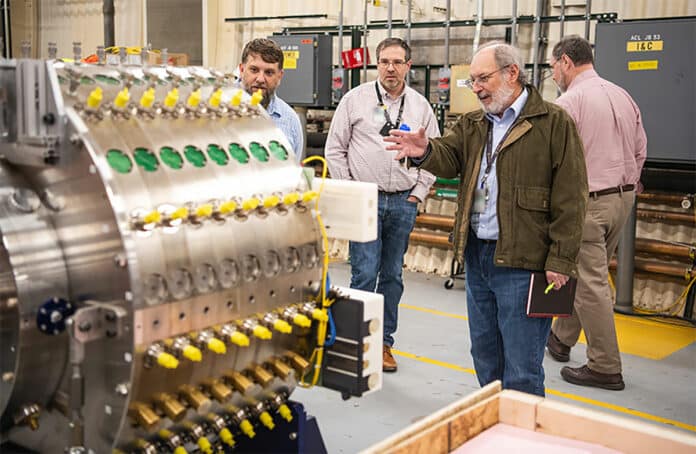The Los Alamos National Laboratory (LANL) has begun assembly of a groundbreaking machine that will allow scientists to study the behavior of plutonium in experiments before the nuclear phase of a weapon’s functioning. The machine will play a vital role in the Laboratory’s mission to ensure the safety, security, and reliability of the United States’ nuclear weapons through computational tools and engineering test facilities.
The plutonium used in the Scorpius Advanced Sources and Detection (ASD) project will never reach criticality, which is a self-sustaining nuclear reaction. However, the tests performed as part of this project will provide essential knowledge about the behavior of this key element in nuclear weapons. The first two accelerator cell modules for Scorpius are currently under construction.
Scorpius accelerator will provide so much data to assess and certify the nuclear stockpile.
The accelerator cell modules are essential parts of a 400-foot-long linear accelerator that will help generate radiographic images of subcritical plutonium experiments. The Scorpius machine will be installed in a tunnel that is almost 1,000 feet underground in the Principal Underground Laboratory for Subcritical Experiments (PULSE).
The primary purpose of Scorpius will be to gather information on plutonium’s aging, behavior, and safety, which will help in creating more accurate computer simulations modeling weapons behavior.
Building cells for conducting experiments with actual plutonium is a complicated and lengthy process. However, Los Alamos has significant experience in constructing similar complex accelerator cells for DARHT, which is used to take high-speed images of mock nuclear devices imploding at speeds greater than 10,000 miles an hour using plutonium surrogates. According to Lab scientists, while DARHT provides extremely useful data, conducting experiments with actual plutonium will open new avenues.
“We are drawing on our expertise with a very advanced predecessor,” said Mike Furlanetto, ASD senior director. “Each of these cell modules is a physical vacuum chamber with magnets, power connection, vacuum pumps, cooling water and controls that must be precision aligned to the next one in line within microns. Getting everything together at that level of accuracy and precision does take some time.”
Los Alamos is building two Scorpius accelerator cell modules, each consisting of three cells. The work on these modules will be completed by the end of 2024. Once the modules are ready, they will be transported to Nevada, where they will undergo testing above ground along with the other pieces of Scorpius. After the testing process is complete, a vendor will be selected to build the remaining 96 cells at the Nevada National Security Site.
Furlanetto mentioned that the optimal number of cells required for the accelerator to perform at its best is 102. He emphasized that this number was chosen after careful consideration. The 102 cells will be arranged into 34 modules, along with an additional backup module, and combined with the remaining components of Scorpius.
The final assembly will take place underground, where the components, weighing about 20,000 pounds each, will be transported by elevator down 1,000 feet to the PULSE tunnel. Furlanetto acknowledged that this posed another challenge, as the design had to be optimized to fit in the elevator. Once completed, Scorpius will be longer than a football field and weigh a staggering 2.44 million pounds.
The Scorpius project involves using solid-state pulsed-power systems to energize an injected electron beam. This will provide power for the accelerator modules. The electron-beam injector, built by Sandia, will send high-energy electron beams that will be broken into four or more pulses, separated by very little time. These pulses will travel down the accelerator, and the accelerator cells will increase their energy to over 20 mega electron volts.
When the pulses near the end of the machine, they will collide with a metal target, generating X-rays that will pass through the plutonium experiment contained inside a steel vessel. Finally, a detector will convert these X-rays into images that will be recorded by a sensitive, high-speed camera. This will give scientists multiple images of plutonium experiments, providing them with significant insights.
“Scorpius will be an extremely important part of our toolset,” said Don Haynes, Los Alamos senior director of the Nevada Programs Office. “It will answer or solve a lot of problems or questions that we’re currently wrestling with.”
Radiographing plutonium under extreme conditions and pressure can provide more accurate data for computer simulation modeling. The experiments carried out as part of the Scorpius project are expected to provide researchers with an extremely sophisticated and detailed understanding of plutonium and weapons behavior. This level of understanding can be invaluable in developing effective strategies for managing nuclear materials and ensuring the safety of nuclear weapons.
“We’re extremely confident in the reliability of the nation’s current nuclear stockpile,” said Furlanetto, “but with Scorpius we will have the ability to explore everything from new materials, new designs, new delivery systems.”
